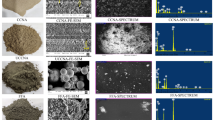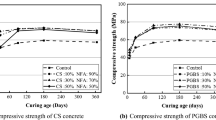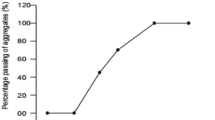Abstract
Cement production evolves high amounts of CO2 which degrades the air quality and the depletion of natural resources is problematic. Cashew nut shell waste obtained from incinerators which extract oil from cashew nut agro-waste by exothermic process is one of the promising alternative materials to the cement which can be used in the construction industry. X-ray diffraction (XRD), X-ray fluorescence (XRF), energy-dispersive X-ray (EDAX) and scanning electron microscope (SEM) analyses explored the microstructural and mineralogical aspects which indicated that Cashew Nut Shell Ash (CNSA) is having similar properties to that of cement. Maintaining the constant fluid-binder proportion of 0.5, cement is substituted by CNSA as 5, 10, 15 and 20% by weight to study the fresh and hardened properties of M25 concrete through slump cone test, compression test and split tensile test. CNSA is considered as a good pozzolan as the strength activity index (SAI) is found greater than 75%. The development of Calcium Silicate Hydrate gel is more predominant in the case of the mix with 15% of CNSA. Improvement of both compressive and tensile strength is observed in the mixes where CNSA is added when compared to the mix without CNSA. It is concluded that using CNSA in concrete is beneficial in reducing environmental and sustainability issues.
Graphic abstract
































Similar content being viewed by others
Availability of data and material
The raw/processed data required to reproduce these findings cannot be shared at this time as the data also forms part of an ongoing study.
Code availability
Not applicable.
Data availability
The raw/processed data required to reproduce these findings cannot be shared at this time as the data also forms part of an ongoing study.
References
Prathyusha P et al. (2020) Mechanical properties of glass fiber reinforced concrete using silica fume and quarry waste as partial replacements. Int J Adv Sci Technol, 29:8230–8243
Kumar MP (2002) Greening of the concrete industry for sustainable development. In: Originally presented as the Tuthill Commemorative Lecture at the Fall 2001 ACI Convention, Dallas, Tex. Concrete International, July 2002
Suhendro B (2014) Toward green concrete for better sustainable environment. Procedia Eng 95:305–320
Shafigh P et al. (2014) Agricultural wastes as aggregate in concrete mixtures—a review. Construct Build Mater 53:110–117. Doi: https://doi.org/10.1016/j.conbuildmat.2013.11.074.
Mehta PK (2009) Global concrete industry sustainability. Concrete Int 31:45–48
Pan Z, Tao Z, Cao YF, Wuhrer R, Murphy T (2018) Compressive strength and microstructure of alkali-activated fly ash/slag binders at high temperature. Cement Concrete Comp 86:9–18. Doi: https://doi.org/10.1016/j.cemconcomp.2017.09.011.
Wetzel A Middendorf B (2019) Influence of silica fume on properties of fresh and hardened ultra-high performance concrete based on alkali-activated slag. Cement Concrete Comp 100:53–59
Thomas BS et al. (2014) Strength, abrasion and permeation characteristics of cement concrete containing discarded rubber fine aggregates. Construct Build Mater 59:204–212
Thomas BS, Gupta RC, Panicker VJ (2016) Recycling of waste tire rubber as aggregate in concrete: durability-related performance, Part 1. J Clean Prod 112:504–513
Yang Z et al. (2018) Recycling of municipal solid waste incineration by-product for cement composites preparation. Construct Build Mater 162:794–801
Rosello J et al. (2017) Rice straw ash: a potential pozzolanic supplementary material for cementing systems. Ind Crops Prod 103:39–50
Kunal KP et al. (2018) Use of silica fume and natural volcanic ash as a replacement to portland cement: micro and pore structural investigation using NMR, XRD, FTIR and X-Ray microtomography. Construct Build Mater 158:574–590
Kalakada Z, Doh J-H, Chowdhury S (2019) Evaluation of strength and durability of lean concrete mixes containing marble waste as fine aggregate. Eur J Environ Civil Eng
Priyansha M, Gupta RC, Thomas BS (2016) Properties of concrete containing jarosite as a partial substitute for fine aggregates. J Clean Prod 120:59–65
Priyansha M, Gupta RC, Thomas BS (2016) Assessment of durability characteristics of cement concrete containing jarosite. J Clean Prod 119:59–65
Bahurudeen A Santhanam M (2015) Influence of different processing methods on the pozzolanic performance of sugarcane bagasse ash. Cement Concrete Comp 56:32–45
Al-Mulali MZ et al. (2015) The incorporation of oil palm ash in concrete as a means of recycling: a review. Cement Concrete Comp 55:129–138
Mo KH, Anor FAM, Alengaram UJ, Jumaat MZ, Rao KJ (2018) Properties of metakaolin-blended oil palm shell lightweight concrete. Eur J Environ Civil Eng 22:852–868
Rattanachu P et al. (2020) Performance of recycled aggregate concrete with rice husk ash as cement binder. Cement Concrete Comp 108:103533
Thandavamoorthy TS (2016) Wood waste as coarse aggregate in the production of concrete. Eur J Environ Civil Eng 20:125–141
Ban CC, Ramli M (2011) The implementation of wood waste ash as a partial cement replacement material in the production of structural grade concrete and mortar: an overview. Resour Conserv Recycling 55:669–685
Chowdhury S, Mishra M, Suganya O (2015) The incorporation of wood waste ash as a partial cement replacement material for making structural grade concrete: an overview. Ain Shams Eng J 6:429–437
Shazim Ali M, Khizar Khan M (2018) Ash blended cement composites: eco friendly and sustainable option for utilization of corncob ash. J Clean Prod 175:442–455
National Minerals Information Centre (2018) Cement statistics and information. United States Geological Survey
Siddique R et al. (2016) Properties of bacterial rice husk ash concrete. Construct Build Mate 121:112–119
Thomas BS, Gupta RC (2015) Long term behaviour of cement concrete containing discarded tire rubber. J Clean Prod 102:78–87
Thomas BS, Gupta RC (2016) Properties of high strength concrete containing scrap tire rubber. J Clea Prod 113:86–92
Amrutha NG, Mattur NC, RajeevaSV (2009) Chloride-ion impermeability of self-compacting high-volume fly ash concrete mixes. Int J Civil EnvironEng 11:29–35
Ecosmart Concrete (2008) Cement production and the CO2 challenge. Environ Imp
Al-Khalaf MN, Yousif HA (1984) Use of rice husk ash in concrete. Int J Cement Comp Lightweight Concrete 6:241–248
James J, Rao MS (1986) Reactivity of rice husk ash. Cement Concrete Re 16:296–302
Kamiya K et al. (2000) Comparative study of structure of silica gels from different sources. J Sol Gel Sci Technol 19:495–499
Saraswathy V, Ha-Won S (2007) Corrosion performance of rice husk ash blended concrete. Construct Build Mater 21:1779–1784
Thomas BS et al. (2015) Performance of high strength rubberized concrete in aggressive environment. In: Construct Build Mater 83:320–326
Thomas BS, Gupta RC, Panicker (2015) Exp Modell Stud High Strength Concrete Contain Waste Tire Rubber. Sustain Cities Soc 19:68–73
Indian Council of Agricultural Research (2019) National Research Centre for Cashew. [Online]. https://cashew.icar.gov.in/aicrpc/.
Statistical Data (2018) Directorate of cashew and cocoa development. Annu Rep, pp 2017–2018
Atul M, Sudhir J, Powar AG (2010) Energy option for small scale cashew nut processing in India. Sci Pub 1:47–50
Tosif (2019) Top 10 cashew nut producing states in India [Major cashew growing states]. top10statesindia.com. https://top10statesindia.com/top-10-cashew-nut-producing-states-in-india/ (Online). 31 Dec 2019
Atul M, Sudhir J, Powar AG (2011) Cashew nut processing: sources of environmental pollution and standards. Bio Info Environ Poll 1:05–11
Samson R et al. (2019) Green thermoset reinforced biocomposites. Green Comp Auto Appl, pp 61–80
Cashew (2011) Wikipedia. (Online). https://en.wikipedia.org>wiki>Cashew
IS 12269 (1987) Specification for 53 grade ordinary portland cement. Ind Stand. Bureau of Indian Standards
Izhar T et al. (2016) Effect of potassium sulphate in the presence of water on the strength of concrete. Int J Sci Adv Res Technol 2:331–334
Namitha S (2004) The activation effect of K2SO4 on the hydration of gypsum anhydrite, CaSO4 (II). J Am Ceram Soc 88:196–201
Ma Y, Qian J (2018) Influence of alkali sulfates in clinker on the hydration and hardening of portland cement. Construct Build Mater 180:351–363
Belie ND, Soutsos M, Gruyaert E (2017) Properties of fresh and hardened concrete containing supplementary cementitious materials. 978–3–319–70606–1.
Liwu M et al. (2014) MgO expansive cement and concrete in China: past, present, and future. Cement Concrete Res 57:1–12
Yang H, Wang Y, Zhou S (2007) Anti-crack performance of low-heat portland cement concrete. J Wuhan Univ Technol 22:555–559
IS 383 (1970) Specification for coarse and fine aggregates from natural sources for concrete. Indian Standards. Bureau of Indian Standards, New Delhi
IS 456 (2000) Plain and reinforced concrete code for practice. Indian Standards. Bureau Of Indian Standards, New Delhi
IS 10262 (2009) Concrete mix proportions guide line. Indian Standards. Bureau of Indian Standards, New Delhi
ASTM C187 (2011) Standard test method for normal consistency of hydraulic cement. ASTM International
ASTM C191 (2013) Standard test methods for time of setting of hydraulic cement by Vicat needle. ASTM International
IS 1199 (1959) Methods of sampling and analysis of concrete. Indian Standards. Bureau of Indian Standards, New Delhi
ASTM C29/C29M-17a (2017) Standard test method for bulk density (“unit weight”) and voids in aggregate. ASTM International, West Conshohocken
IS 516 (2018) Method of tests for strength of concrete. Indian Standards. Bureau of Indian Standards, New Delhi
IS 5816 (1999) Splitting tensile strength of concrete—method of test. Indian Standards. Bureau of Indian Standards, New Delhi
Ramesh Babu TS, Neeraja D (2017) An experimental study of natural admixture effect on conventional concrete and high volume class F fly ash blended concrete. Case Stud Construct Mater 6:43–62
Ramesh Babu TS, Neeraja D (2016) Effect of natural admixture on fresh properties and compressive strength of class C fly ash blended concrete. Asian J Civil Eng 17:373–384
Megat Johari MA et al. (2011) Influence of supplementary cementitious materials on engineering properties of high strength concrete. Construction Build Mater 25:2639–2648
Adel K et al. (2014) Effect of mineral admixtures and steel fiber volume contents on the behavior of high-performance fiber reinforced concrete. Mater Des 63:493–499
ASTM C618 (2005) Standard specification for coal fly ash and raw or calcined natural pozzolan for use in concrete. ASTM International, West Conshohocken
Ramesh Babu TS et al. (2016) An experimental study on effect of natural admixture on mechanical properties of class C fly ash blended concrete. Asian J Civil Eng 17:737–752.
El-Hassan H, Kianmehr P, Z Souhail. (2019) Properties of pervious concrete incorporating recycled concrete aggregates and slag. Construct Build Mater , Vol. 212, pp. 164–175. 0950–0618.
Bahurudeen A et al. (2015) Performance evaluation of sugarcane bagasse ash blended cement in concrete. 59:77–88
Nasir S et al. (2015) Calcined Kaolin as cement replacing material and its use in high strength concrete. Construct Building Mate 81:313–332
Ramesh Babu TS et al. (2018)Effect of natural admixture on durability properties of conventional and class C fly ash blended concrete. Ind Concrete J 6:70–79
Siddique R (2011) Properties of self-compacting concrete containing class F fly ash. Mater Des 32:1501–1507
Guru Jawahar J et al. (2013) Design of cost-effective M 25 grade of self-compacting concrete. Mater Des 49:687–692
Wakizaka Y et al. (2001) Deterioration of concrete due to specific minerals. In: Proceedings of the aggregate, environment and economy, pp. 331–338.
Henderson DM, Gutovsky HS (1956) Virtual museum of minerals and molecules. Min Mol Project. https://virtual-museum.soils.wisc.edu/display/portlandite/ (Online)
Guo, Z et al. (2016) Concentrate on buoyancy tailings of kaolinite-type pyrite when utilized as bond admixture and solid admixture. Procedia Environ Sci, pp 644–652.
Hamzaoui R et al. (2019) Introduction of processed kaolinite acquired by6 mechanosynthesis to concrete blend for the generation of mortar: study of mechanical execution of adjusted mortar. Powder Technol, pp 340–348.
Fan Y et al. (2015) Effects of nano-kaolinite clay on the freeze-thaw resistance of concrete. Cement Concrete Comp 62: 1–12
King HM Geology.com. (Online) https://geology.com/minerals/calcite.shtml.
Goldstein JI, Newbury DE, Michael JR, Ritchie NWM, Scott JHJ, Joy DC (2003) Scanning electron microscopy and X-Ray microanalysis. Kluwer Academic Publishers, New York. 978–1–4615–0215–9
Holton I (2012) Is energy-dispersive spectroscopy in the SEM a substitute for electron probe microanalysis?. Microscopy Anal. 141:S4–S7
Michal Z (2007) Introduction to X-Ray microanalysis. Silesian University of Technology Publishing House, Gliwice. 978–83–7335–458–6.
Acknowledgements
The authors want to thank Dr. Sridhar Balasubramanian, CSIR-Indian Institute of Chemical Technology, Hyderabad, for his work in directing XRD and XRF examinations. M.J. Kishore extends his gratitude toward the technical personnel of Vellore Institute of Technology, Tamil Nadu for their assistance in performing Electron microscopic analysis as well as in experimental work.
Funding
This research received no specific grant from any funding agency in the public, commercial, or not-for-profit sectors.
Author information
Authors and Affiliations
Corresponding author
Ethics declarations
Conflicts of interest
On behalf of all authors, the corresponding author states that there is no conflict of interest.
Rights and permissions
About this article
Cite this article
Mendu, J.K., Pannem, R.M.R. Assessment of mechanical properties of cashew nut shell ash blended concrete. Innov. Infrastruct. Solut. 6, 227 (2021). https://doi.org/10.1007/s41062-021-00586-x
Received:
Accepted:
Published:
DOI: https://doi.org/10.1007/s41062-021-00586-x




